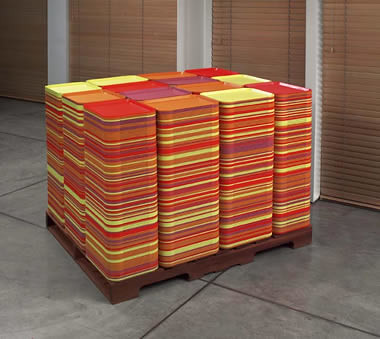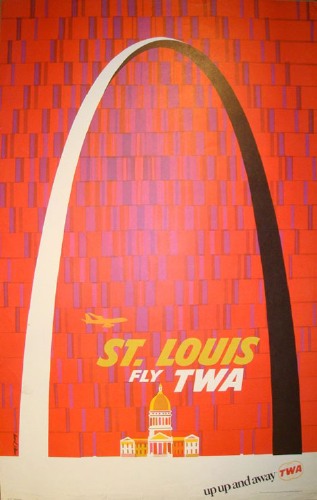
Grain Edit has some truly spectacular gouache/lithograph-based advertising work done for the late TWA by the late David Klein. It’s one truly beautiful poster after another, starting with this piece featuring the Gateway Arch.
Tyler Green just got back from St Louis, where he was blown away by Saarinen’s arch, and rightly so. It is a sculptural and engineering marvel. Seeing as how I’d just loaded up the ol’ blog here with shiny stainless steel sculptures by Walter de Maria, Tyler put forward an interesting idea, namely that there might be some significant-but-under-acknowledged [or under-examined] connection between Saarinen’s arch and de Maria’s own truly great addition to the shiny, dropdead gorgeous Western Sublime, the Lightning Field. Very interesting.
Meanwhile, for my part, I realized that I might have been inadvertently quoting a Klein myself. Because way back when I was still a hardcore suit and setting up private equity funds for whichever giant retailers, I had a crazy idea to make some paintings [I know, right?] of Times Square, where all the billboards were replaced by floating, perspectival parallelograms of solid color.
At the time I was thinking Malevich, especially the photo of the gallery installation of his paintings with that one square black one tucked up into the corner. As I describe it, it probably sounds a little Mehretu-ish, but she wasn’t on the scene yet.
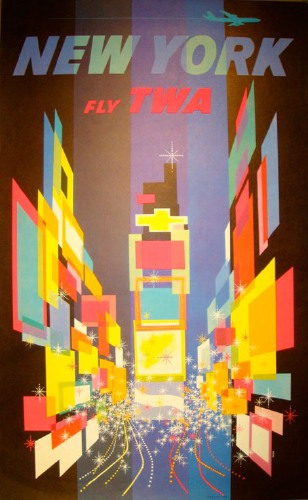
But as I look at it in my head, I recognize it now as the billboards in David Klein’s New York TWA poster–which has been in MoMA’s A&D collection for over 50 years. It’s like I’m running a private install of fffound! in my head, and it takes this long to figure out where all the images actually come from.
David Klein Vintage TWA Posters [grainedit.com]
Fly TWA, David Klein, 1956 [moma.org]
David Klein Art [davidkleinart.com]
Isolated Depiction of the Passage of Time
As Antoni helpfully pointed out in an email, Canadian artist Brian Jungen has created a work wherein he carves a design into the gallery wall with a router, which leaves a bevel-edged channel which, as one viewer in Vancouver described it, “revealed all the coloured layers of paint like layers of sediment.”
Sounds awesome, and awfully similar to Huyghe’s and ___?__’s pieces. And Jungen’s one-man show did travel to the New Museum’s temporary Chelsea location in 2005. [Which is kind of problematic: did the New Museum’s 22nd Street space walls even have hundreds of coats of exhibition-related repainting to expose and contemplate? And so what happens to this work without the supposed burden of Art History lurking right behind that fresh coat of paint? Please tell me there’s more to a piece like this than expedient aesthetic pleasure.]
And anyway, I didn’t see Jungen’s show. Which is really too bad, because this piece sounds kind of sweet. Isolated Depiction of the Passage of Time, 2001:
consists of a handcrafted cedar pallet that is surmounted by neatly stacked cafeteria trays in several colors. While the form can be understood in terms of the classic minimalist cube, it is also a facsimile of an escape pod that was fashioned by an inmate at one of Canada’s largest prisons. Knowing that the cafeteria trays were delivered by truck to another facility for cleaning, the prisoner had built up and glued together many cafeteria trays, leaving a void at the center in which he could hide while the trays were being transported. In this sculpture the void is taken up with a television playing daytime programming and soap operas.
Hmm, not getting the TV aspect, but still. It’s got some nice Tony Feher-meets-Swiss Baroque-period Judd-meets-early Michael Phelan vibe going on. Also, and obviously, the title just backed into me in the lunch line.
The Passage Of Time Obscures The Past Somewhat
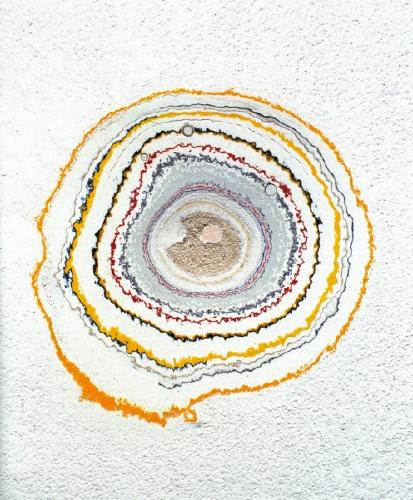
And speaking of “The Quick And The Dead,” I swear I’ve seen a nearly identical piece to Pierre Huyghe’s Timekeeper, 1999, before.
I thought it was at the 1995 Whitney Biennial, on the east wall of the central gallery, opposite the Ellen Gallagher paintings. Only instead of sanding down the layers of paint on the gallery wall to reveal the space’s history like tree rings, the Whitney version was chiseled or routed out, leaving a smooth, beveled edge.
Did it make a shape like a striated, inverted Mayan pyramid? Or was it more of a trench, like a miniature LA River running horizontally across the wall? Was it by Lawrence Weiner? Am I right on the wall, but wrong on the show and date?
Above The Weather
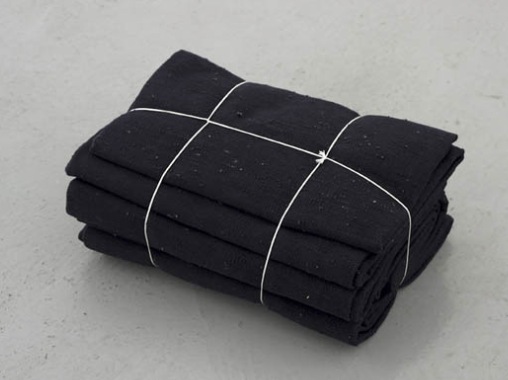
Clearly, I miss some good things that are posted to the Walker Art Center’s blogs in between my visits. Such as Peter Eleey’s discussion last April on the opening of “The Quick And The Dead,” the Walker’s exhibition of conceptual art and the limits of our knowledge and experience.” Whoa, no small plans, then.
From the page above, it’s not clear that Jason Dodge’s Above The Weather is actually included in the show, but it sounds rather nice. He commissioned an Algerian weaver, Djidjiga Meffrer, to make a tapestry from a length of thread that can reach “to where the weather ends-essentially the border with outer space,” Eleey said. “Though it leads your mind to the outer reaches of the atmosphere, the cloth turns out to be much smaller than you might think.”
According to the Kadist Collection in which this piece [example?] resides, the color is the color of a night in 2007. Which is either interesting or a typo; the piece itself is dated 2005.
The Quick and The Dead runs through Sept. 24 [walkerart.org via briansholis.com]
Things Fall Apart: Au Centre Cannot Hold
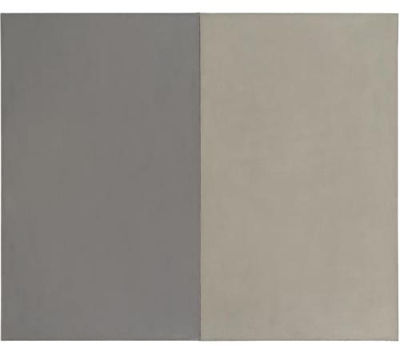
Ouch. As if things weren’t bad enough in the art world last October, a 1969 Brice Marden diptych titled Au Centre fell off the brackets in its travel crate while in transit from Moscow to New York. The fall apparently went unnoticed until the painting arrived, which meant its fragile oil and beeswax surface jostled and rubbed against the inside of the crate all the way home. It was destroyed, and now after paying out the $3 million claim, the insurer AXA Art is suing the hell out of everyone who ever touched the painting or the crate. [The case just moved to federal court in Manhattan after a couple of months in NY State Supreme Court.]
The owner is/was Gagosian Gallery. According to the NY Post, the painting was en route to Manhattan to be sold at Sotheby’s. Which is odd. The original court filings had Au Centre leaving Moscow on October 9, 2008. [Actually, the date is listed as October 9, 2009. Which, if it were true, means AXA could just make sure someone’s properly escorting the painting in the future, and there’d be no trouble at all.] Gagosian had just opened a major show in Moscow a couple of weeks before, a nearly encyclopedic survey of contemporary art. Which did not, though, officially include the Marden. So maybe it was there for a back room showing, or as extra inventory? Who knows?
But we do know that the crate makers named in the suit are from Brooklyn. And the painting had last been seen in New York–at Sotheby’s. Despite its general awesomeness as an early Marden, Au Centre was a notable disappointment in the fall 2006 contemporary auction. The painting had both a high estimate [$3.8-4.5 million] and a guarantee [?], but it went unsold.
And it’s not so clear that Larry just snapped it up on the rebound, either. The painting is listed as coming directly from dealer Yvon Lambert, who had purchased it from his own 1969 show in Paris of Marden’s work. Yet Artforum seems to imply in their coverage of the sale that Bob Mnuchin was the “constipated”-looking seller.
Maybe he was the buyer. In 2006, Sotheby’s had yet to institute a disclosure policy for third-party guarantees, or as they eventually called them, “irrevocable bids.” In the late boom, third-party guarantees were a popular, if dodgy way for auction houses to extend guarantees to sellers while mitigating their own risk. But they were also a great way to reward big collectors and financiers, who reaped a significant portion of the surplus if a work sold beyond the guaranteed price. In other words, the guarantor was paid hundreds of thousands or millions of dollars not to buy the work. And they provided the sure public appearance of a sale, preventing the work from acquiring the aura of, uh, damaged goods.
Though I guess that didn’t happen here. And somehow Larry gets an early Marden for $3 million. In New York at the beginning of 2007. Given that auction history, it seems odd to me that in the Fall of 2008, with the art market bubble popping, Gagosian would really have been planning to put the painting back into play at Sotheby’s New York.
l’Arroseur Arrosé
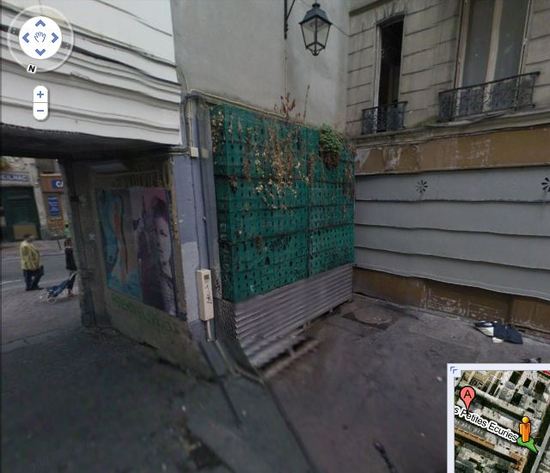
Maybe it’s a matter of missing the reportorial bowl, but Paris’s experiments with anti-public urination architectural technology are more interesting than the Wall Street Journal makes them out to be.
First off, the utter untimeliness of the story. Paris’s public toilets have been free since 2006. The single anti-urination wall, or mur antipipi, mentioned in the piece has been in place since 2005. The UK Telegraph and the Guardian re-covered the topic at length in 2007, basically by translating a Nouvel Observateur story featuring Etienne Vanderpooten, municipal architect for the City of Paris, and the inventor of the mur antipipi.
We’ll get to that in a minute. Among the other piss-thwarting streetscaping strategies: filling corners with “treacherous concrete cones”; and a steeply sloped “granite parapet” which is designed to be hard to stand on, especially after “la 3e cannette de bière.”
But here’s the wall from Google Streetview. About the zig-zag profile, Monsieur Vanderpooten explained it with a cinematic reference: “The jet of pee is rather oblique. If it meets a sloping surface it is sent back to the trousers…It is the case of the arroseur arrosé.”
Originally titled, le Jardinier, l’Arroseur Arrosé, or The Waterer Watered/ Sprinkler Sprinkled, was one of the Lumiere brothers’ first short films. It was shot in the Spring of 1895, first screened in June, and it was one of the ten shorts in the Lumieres’ first public cinema screening in December. Other shorts captured slices of life or street scenes; l’Arroseur Arrosé was the first one staged for the camera, the first comedy/gag, and some would argue, the first cinematic narrative.
You can imagine a remake set in the corner of the Cour des Petites Ecuries and starring a drunk football fan who step out of a nearby tabac would be pretty damn funny.
Ruminations On The Immortality Of Art
Ryan McGinley in Vice:
[Dash] and Earsnot also loved to tag bums. They would give a bum $20 to let them tag all over his clothes. Bums never change their clothes, so the tags would never get buffed out like on a door or grate. And they just wander the streets. It was amazing advertising and such a genius idea that it still makes me crack up when I think about it.
Haha, good times.
Remembering Dash Snow [viceland]
Stickin’ It To The Man
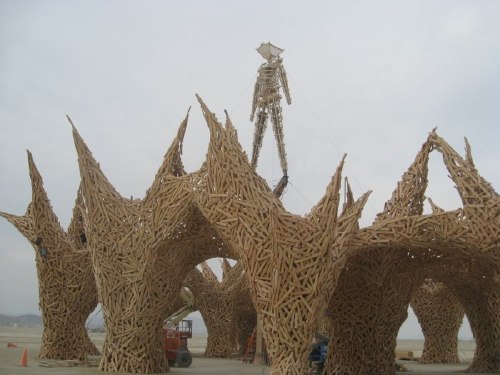
Classic. Throw it on the compost pile; it is done. Burning Man’s official delusional complicity in its own cynical corporate exploitation is now complete.
This year, the Man has been set atop a pyre [above] made of 2x4s swirled into a fantastical, organic architecture designed by Rod Garrett. The design is an explicit reference to Uchronia, aka the Belgian Waffle [below], from the 2006 Festival.
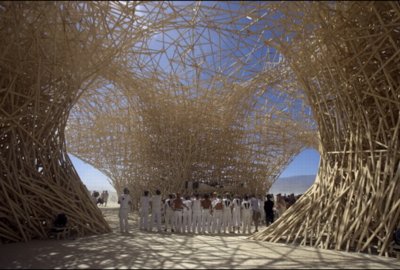
The Waffle was controversial for many reasons: it was built in the open playa, not in the city. It was burned the night after the Man burned. At the time, the Waffle’s Belgian designer/marketer Arne Quinze claimed his 100-person crew were all volunteers, but it turned out they were all paid employees. Because it was later revealed that the entire Uchronia Project was an experiential branding campaign organized and executed by Quinze’s agency for the launch of the newly redesigned Lexus L460 luxury sedan.
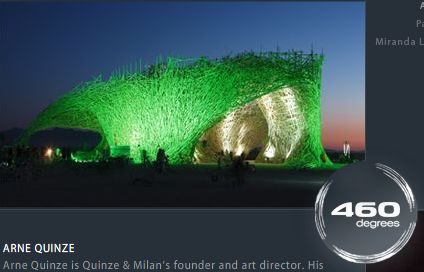
See, Burning Man turned out to be only the opening act, the precursor for several Lexus pop-up showrooms with mini-Waffle installations, including one in Beverly Hills and another in Miami Beach which was timed to coincide with Art Basel.
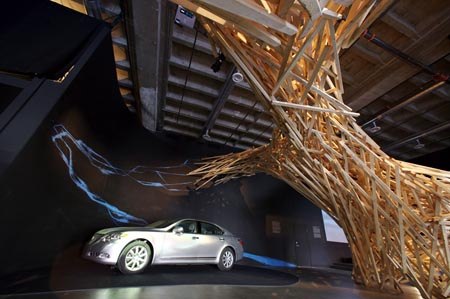
At the time, I got a lot of grief over my criticism of Quinze’s spectacle, and burners, including the BM organization’s official curator, were in angry denial about what had really happened. [My inbox got predictably quiet after the rest of Quinze’s elaborate Lexus installations were unveiled.]
All that mattered was for burners to believe–even if just for a few days–that there was still a chance to escape the consumption-obsessed world, and to create, free from advertising and logos and clients and bullshit corporate sponsors and their moneygrubbing agendas.
And now, just three years later, the namesake of the festival is built on a replica of the biggest corporate punking and co-option ever. Congratulations.
Working for the Man; The State of the ART [top image via blog.burningman.com]
Relive the complete greg.org Uchronia=Lexus saga here.
More Small Metal Objects
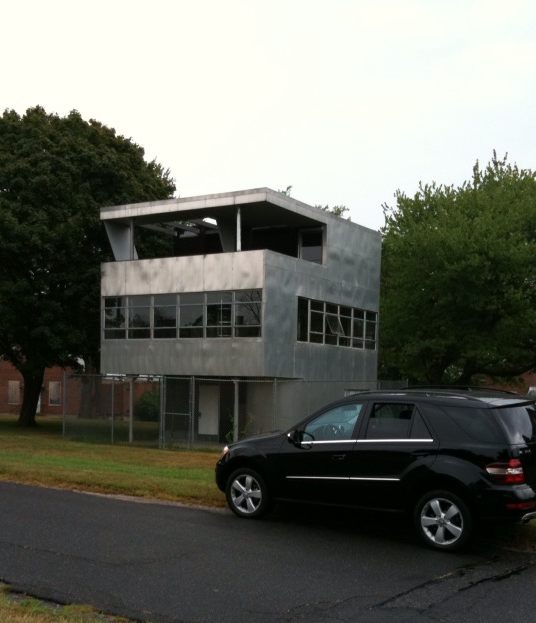
greg.org reader Kara C. just sent along this new photo of A. Lawrence Rocher & Albert Frey’s Aluminaire House, a fantastic early prefab design–and Frey’s first building in the US–which is currently parked on the Islip, LI campus of the NY Institute of Technology.
When it was first exhibited in NYC in 1931, the speed with which it was built [10 days] led people to call it the “Zipper House.” But NYIT architect Michael Schwarting, who was instrumental in saving the house from demolition in the late 1980s said, “It was made more like a refrigerator than a house.”
And as that M-Class clearly demonstrates, the Aluminaire House is barely the size of a Sub-Zero in a Five Towns McMansion.
Kocher & Frey’s Aluminaire House: a making of primer
another contemporary view from early August
Another In An Apparently Infinite Series
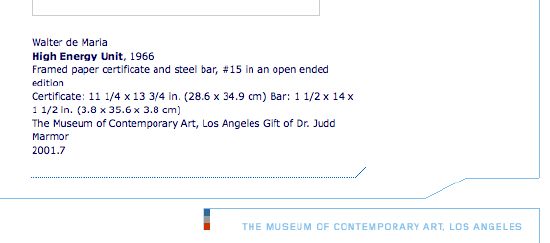
See what happens when you just ask? My posts the last couple of days about [mis]remembering Walter de Maria’s 1966 stainless steel sculpture, High Energy Bar/ High Energy Unit, is shaking loose some interesting bits of information on the work and the burst of popularity of “multiples” as a democratic, anti-elitist, market-thwarting strategy for artmaking in the 1960s. [I’m sure there are enough unsupported assumptions packed into that sentence to make a whole CAA-ful of art historians’ eyes bleed, but whatever, close enough.]
First up, de Maria discussed High Energy Bar with Paul Cummings in 1972, in his interview for the Smithsonian Archive:
WDM: …But I mean there’s some relationship between being able to go smaller and smaller through the electron microscope and at the same time still not be able to see all the galaxies in outer space. But I do think that in ten or twenty years somebody will say, well, that’s a minimal situation, or that’s a minimal or that’s minimal art. I think that that will stand. The point was that in the development of these boxes and rectangles it wasn’t just making another piece of geometric sculpture, because there’s been a lot of geometric sculpture in the last fifty years, but of the relationship between this angle and that angle or this box and that box or even David Smith’s last sculptures, you know, the boxes and cubes which in a way was a sort of three-dimensional cubism some sixty or seventy years later, fifty years later, or whatever. But, it was the idea that you could take a perfect cube, perfect rectangle such as the high energy bar, the perfect rectangle and, well, I’ll show you a high energy bar in a moment, and the notion that its ideas and its lines were so perfect and so perfectly composed and self-contained that it was perfectly satisfying to look at that one object as a sculpture without having it confused with a lot of needless relationships. It was perfectly focused on itself and implied a lot more than it was.
PC: You still make those, don’t you?
WDM: The high energy bars, yeah. I’ll make those all my life.
PC: It’s an open-ended multiple.
WDM: That’s right, and I didn’t like the word “multiple.”
PC: Did you think of them in those terms?
WDM; Well, I would say when I started making them in ’65, ’66, the ideas of multiples was just growing about that time and I thought that if a person accepted the idea of a multiple that it should be open-ended, because why, if you have mass-produced technology, why should you limit it at fifty or a hundred or two hundred, because the technology is inexpensive to make . . . .
PC: You have to want that limitation.
WDM: Yeah, and so I sort of thought if I ever did that that probably multiples should be completely continuous.
So yeah, “make those all my life,” but I also like that part up top about these perfect, reference-free metal objects and the once-future convergence of science and minimalism. The latter, of course, feels like validation of what I already think, and the former seems completely undermined by his sculptures’ formal similarities to objects like the Meter–though the PKU’s conceptual conceit that a kilogram is equal to itself does kind of close the loop nice and tightly.
Anyway, onward and upward with the arts. From a reader far more learned than myself on these matters, Kathleen Campagnolo, who is just finishing her PhD on the 1960s sculptures of Walter de Maria, and who apparently has a Google alert set for all mentions of “High Energy Bar -triathlon,” comes this:
the artist’s statement from “3 → ∞ : new multiple art,” a 1970 exhibition at the Whitechapel Gallery, which included Virginia Dwan’s example of High Energy Bar, No. 53:
High Energy Bar
Work on the High energy bar began in 1965. A summation of my minimal investigation in sculpture going back to 1961/62 – the nature of the rectangle.
First bar issued in 1966.
This is my answer to the multiple – not a multiple. I detest multiples (in art).
Differs from most multiples in several respects:
1st) Infinite edition – not limited. I shall make them all my life.
2nd) My personal connection with each bar. With each bar is issued a certificate.
I collect the following information:
Name of owner
Address
Number of bar
And after no. 50 photograph of owner.
3rd) Bars are not transferable. The bar always belongs to the person who gets it first, i.e., if after a person dies the bar were ‘given’ to someone else – that new person would have the first person’s bar – he would not have the bar for himself, i.e., it would not be his bar.
Records of the owners of the bars are kept in a Swiss bank. Needless to say the ownership of all bars is known only to myself and never divulged.
I love it, and not just because that last part, about the bars being non-transferable, makes me feel like I was kind of right all along. If anything, this just adds a new desirability factor to the High Energy Bar secondary market. They’re like Friends of Walter trading cards. Now it’s not just a question of how low the edition number is, but who the first only true owner is/was.
Also, Swiss bank!
You should be able to buy the catalogue for Three To Infinity: New Multiple Art more cheaply than these Amazon dealers [amazon]
Engraved On My Memory, Perhaps
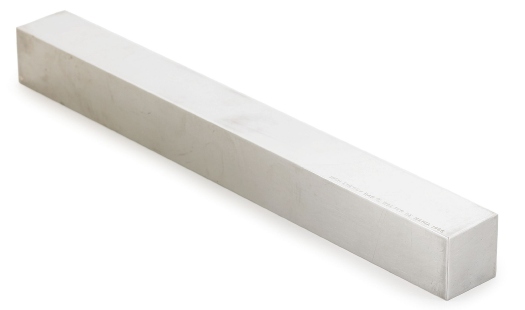
After blogging about it the other day, I thought it was high time I get the real story on the mysterious Walter de Maria stainless steel edition I’d been watching for all these years, the one which has never come up for auction or resale because the artist engraved a restriction on the work itself that it could never be resold for more than $100.
So I called the collector, Charlie Cowles, and asked him about it. Which I probably should have done years ago, because I remembered the work completely wrong.
The piece is actually titled High Energy Bar, and the only thing engraved on it is the title, the artist’s name, and the date, 1966. And a copyright notice, because I guess that’s how they used to do it back then. [Any questions, just ask Robert Indiana what he thinks about it.] But a $100 resale restriction? Charlie said he’d never heard it.
That’s when I realized what had actually been engraved where. Turns out when I’d asked about the piece 15+ years ago, Charlie had explained that he’d gotten it in 1967 from de Maria’s Los Angeles dealer, Nicholas Wilder for $100, and that because it was an unlimited edition, it’d never sell out. That price number and the idea of perpetual availability had lodged in my brain, and over the years, had gotten conflated with the object itself.
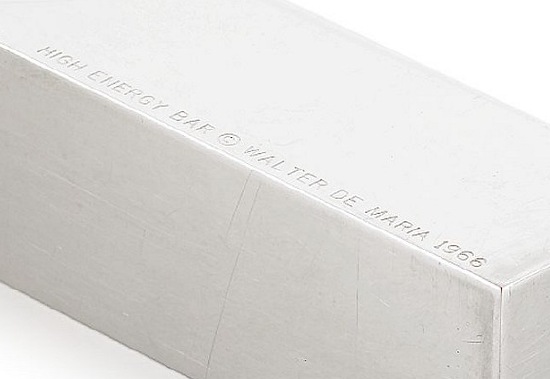
Once I figured out the mystery of High Energy Bar, I realized examples of it have been shown and sold all over the place throughout the years. [Though Betty Freeman had one, too, it wasn’t included in the Christie’s auction of her collection.]
The most recent instance pretty much pokes a hole in my market-proof $100 de Maria delusion. In May, a High Energy Bar belonging to the late gallerist Eva af Buren was sold in Stockholm. It went for 220,000 SEK, nearly USD31,000, and more than ten times the pre-sale estimate.
af Buren’s de Maria, which she acquired in 1969, was no. 49 of what the certificate calls “an infinite series.” Not only is the certificate required “in order to be operative and authentic,” but the certificate–depicted below, and let me state for the record, that is one of the snazziest artist certificates I’ve ever seen–“will be incorporated as a part of the whole work of art, to be known as the High Energy Unit.”
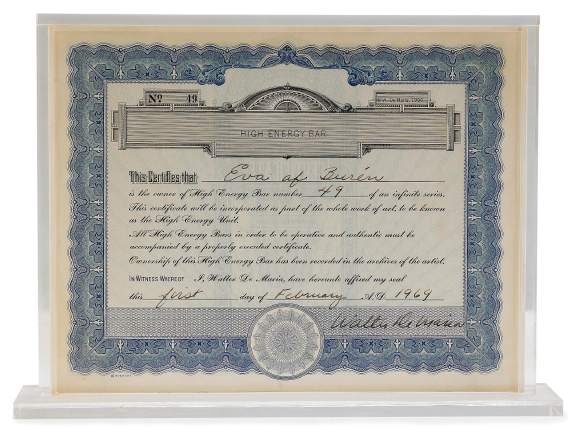
Interestingly, though there are hundreds of mentions of High Energy Bar, there were only two mentions of the “complete” piece, High Energy Unit. [It makes me start to wonder about the underappreciated existence our poor certificates must lead, even as they’ve become so important to the authenticity and integrity of the work. Is anyone else making sexy artist certificates–or art about certificates, even–that remain ignored or unknown by everyone but the work’s purchaser? Will an artist make a work whose aesthetic or artistic payoff is actually the [secret] certificate itself? If you have or know of any awesome certificates languishing in any file cabinets out there, by all means, let me know.]
Next step is to check with de Maria and see if these High Energy Bars are still available, or if the series’ infiniteness has become, like infinity itself, more of an abstract concept. It makes me wonder what number it’s reached. And what it sells for.
It could be possible that even if the work is still available from the artist himself, collectors could put a premium on vintage examples with low numbers and historically interesting provenance. Like how On Kawara’s older date paintings sell for significantly more than newer ones, or how Flavins with “vintage” light fixtures sell for more than those with replacements. Frankly, it seems like a valuation system that’s explicitly at odds with the artist’s concept of the work itself. And maybe it’s something that the market will slowly process and correct for as conceptually driven work becomes better understood.
Where Are We Going? And What Are We Doing?
If I’m reading John Cage’s first book Silence: Lectures and Writings correctly, this is a quote from “Where are we going? And what are we doing?” a lecture/text/performance piece he first performed at Pratt in 1960:
I was driving out to the country once with Carolyn and Earle Brown. We got to talking about Coomaraswamy’s statement that the traditional function of the artist is to imitate nature in her manner of operation. This led me to the opinion that art changes because science changes–that is, changes in science give artists different understandings of how nature works.
A Phi Beta Kappa ran in the other day and said, “Your view is that art follows science, whereas Blake’s view is that art is ahead of science.”
Right here you have it: Is man in control of nature or is he, as part of it, going along with it? To be perfectly honest with you, let me say that I find nature far more interesting than any of man’s controls of nature.
Cage reprised this piece in 1963 at The Pop Festival in Washington, DC, which was the performance/dance/Happenings portion of “The Popular Image,” the Washington Gallery of Modern Art’s first Pop Art exhibition.
I don’t know what harder to get my head around: that Cage performed in DC; that he was considered a Pop Artist; or that DC had a Gallery of Modern Art.
Adolfo! Adolfo!
So I sneaked out last night to see Inglourious Basterds, which I found to be generally fantastic; Brad Pitt’s craft has come a long way since Meet Joe Black.
Because, I confess, I’m still working through a stack of badly panned & scanned DVDs of lost grindhouse epics, I have fallen behind in my study of spaghetti westerns and the lesser-known works of Lee Marvin. And so I was worried that Tarantino’s many subtle, referenzia cinematografistica which so many esteemed critics alluded to might slip by me unnoticed–and if that happens, what’s the point, right?
I needn’t have worried. From the twangy, scratchy get-go, where the opening track sounded like it was being played back on Hi-Fi to mimic the apparently primitive audio post-production facilities of Italy [1], Tarantino is not shy–hah, as if–about his stylistic references.
Oh, and contrary to some opinions, I thought Mike Myers was spot-on. I’d always joke-assumed Pitt won the Travolta/Forster/Carradine/Russell casting lottery this time as the actor whose forgotten talents and fizzling career would be nobly rescued by the director fanboi who Never Forgot. But I was wrong; it’s Myers. You now have at least two years where we won’t hold The Cat In The Hat against you, Mike. Use them well.
Anyway, the point, and the thing I either overlooked or never heard, was what a big, fat, sloppy kiss to the cinema this thing was. And not just the blatant, “Make me a Cannes juror for life!” applause line [“I’m French. We respect directors in this country.”] either. I’m talking about how the whole plot is basically the basterd child of The Dirty Dozen and Cinema Paradiso.
Also, *SPOILER ALERT?* was there NOT a shoutout to the end of Raiders of The Lost Ark? Does this mean Tarantino’s officially moved onto hommaging 80s pop film now? I see Michael Schoeffling as Robert Forster.
[1] Whenever he gets around to making it, I’m sure QT’s Punjabi murder musical will sound like it was recorded in the bathtub.
1,000 Fake Giacomettis Look As Shitty As They Sound
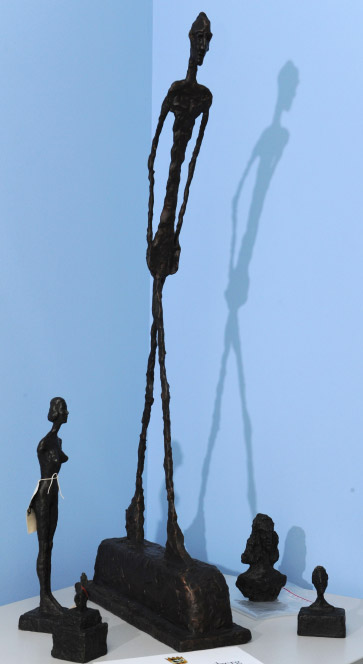
Three people–a 59-year-old phony aristocrat and an art dealer couple in their 60’s–were arrested in Stuttgart, Germany for fraud and copyright infringement [!] after police broke up an international Alberto Giacometti forgery operation. Over 1,000 fake Giacommetis were confiscated from storage space in Mainz, outside Frankfurt. The Frankfurt Allgemeine Zeittung photographed a few of them [above] at the police’s invitation. Seriously, I don’t see how the copyright infringement charges will stick, because those things look like crap.
If I understand the Google translation of FAZ correctly, the forgers created an elaborate backstory to support the existence of so much unknown Giacometti material.
The main suspect, who hasn’t been named by police, called himself an “Imperial Count,” and claimed to have been entrusted the works by his dear, dear friend in Paris, Diego, Alberto’s sculptor brother, who died in 1985. According to the count, Diego accumulated a massive stash of Alberto’s sculptures–both casts and plaster originals–from the foundry they shared. The works were kept hidden from Alberto’s widow and heirs [Alberto died in 1966].
Why? Perhaps the answer is to be found in the 139-page book, Diego’s Revenge, which explains the history of the brothers’ rivalry and which supported the works’ authenticity. Because, of course, it had been written and published by the scammers themselves.
In their press release [pdf auf deutch, google translation], the State Crime Prosecutor in Stuttgart had some valuable advice for Giacometti collectors and other art collectors alike:
Prevention tips for the purchase of works of art:
Before you buy:
- Avoid impulse buys and so-called “bargains”
- Evaluate the offer for sale carefully
- Find out on the basis of literature (picture books, work folders) on the Purchase
- Überlassen Sie in Zweifelsfällen die Bewertung sachkundigen Dritten (Sammler, • Do not leave in doubt the valuation expert third party (picking, Dealers, museums, etc.)
- Compare the offer and the prices on the art market
When buying:
- Buy your art only against an invoice or purchase contract (§ 433 BGB)
- Write down in a private purchase, the identity of the seller, its Address and possibly also his license plates [especially important if you’re buying a Giacometti out of the trunk of a car. -ed,]
- Let the defining characteristics (originality, age, artists, etc.) be confirmed in writing.
So servicey!
Now that I think about it, there was a Giacometti Femme de Venise VI for sale last May at Santa Monica Auctions. It didn’t look like any of the published Femmes de Venise, which were numbered differently over the years, but it still has a foundry mark, and they still had a $25-30,000 estimate on it, even though SMA described it as “After Alberto Giacometti.” Never mind, I just spoke to the auctioneers, and that piece had been in a Los Angeles collection for over 40 years. Whatever it is, it’s not a German fake.
Die Gangster von Mainz [faz.net via artforum]
The SA-60 Spherical Airship
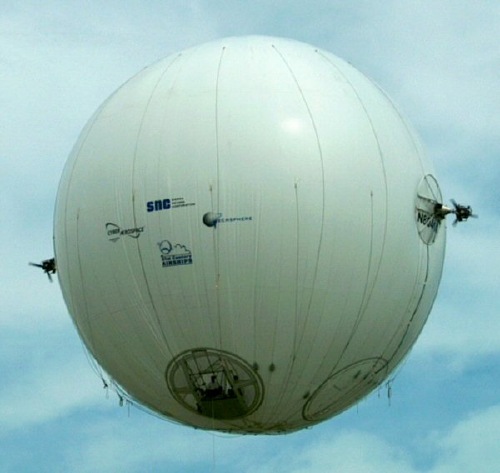
According to BoingBoing, the Sierra Nevada Corporation’s been testing its SA-60 Spherical Airship at the Reno-Stead Airport. [SNC’s the same company whose surveillance blimp was set to be mooned this month by 1,500 hundred angry Canadians in the quiet border downs of Sarnia/Port Huron. I think high winds scuttled the ballooning, and hence, the mooning.]
The SA-60 [above] was first demonstrated successfully in 2004 by a knot of gruff-sounding defense contractors–none of whose domain names work anymore. At the time, the manned, operational version–suitable for use “for both defense and homeland security purposes including surveillance of battlefields and domestic borders and ports.”–was expected to have a diameter of 76 feet. An unmanned, solar-powered version would have a diameter of 200 feet.
Since I’ve got my hands full turning satelloons and other fantastic, spherical balloon airships into art, I hope someone else will pick up the slack and start celebrating the glorious poetry that is the military industrial complex press release. God Bless America!:
Press Release: July 1, 2004
SNC Enters Exclusive Partnership with Proxity Digital Networks Subsidiary
Cyber Aerospace and Techsphere Systems on Spherical Airship
Sparks, Nevada – (July 1, 2004) – Sierra Nevada Corporation announced today that it has entered into an exclusive partnership agreement with Proxity Digital Networks subsidiary Cyber Aerospace and Techsphere Systems to provide technology, payload and sensor integration for government and commercial end users of the SA-60 Spherical Airship.
Proxity Digital Networks, Inc. and Techsphere Systems International, Inc., recently announced through Cyber Aerospace Corp., an operating subsidiary of Proxity’s On Alert Systems, that the SA-60 low altitude surveillance airship has flown at 10,000 feet altitude with a payload exceeding 500 pounds, thus satisfying all flight criteria required under existing contracts. The 10,000 ft. flight took place as Cyber Aerospace conducted contractor demonstration flights for the U.S. Navy at Captain Walter Francis Duke Regional Airport in Hollywood, St. Mary’s County, MD.

